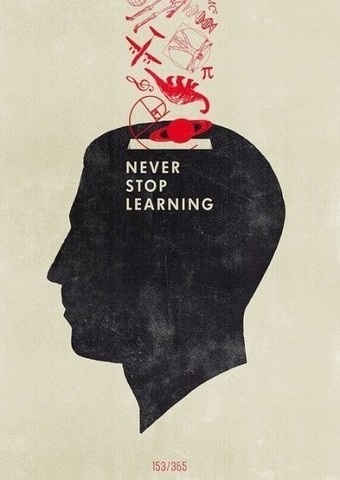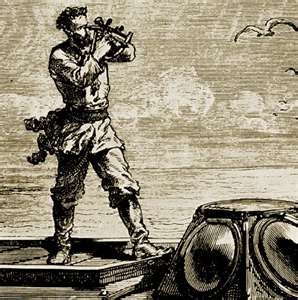
In September, I will take up a new post as Assistant Headteacher at my current school. Amongst other things, I will have responsibility for developing aspects of school life which will impact directly on the culture of learning in the whole school. These responsibilities include, provision for ITT, NQT and RQTs; pupil researchers; provision for the Most Able; the Learning to Learn curriculum and CPD. So, while I will not be ultimately responsible for determining the direction of Learning and Teaching (my dream job), I will play an important part in growing a learning culture amongst both pupils and staff. Not only, that but I will be a part of the CPD steering group for the Teaching School Alliance of which my school is a member. There are exciting times ahead.
Alex Quigley (@huntingenglish) once told me that, for him, blogging was thinking and so it is my intention to try and think through every aspect of my new role in a series of posts. As this will be an exercise in ‘thinking out loud’, please make allowances if my ideas are sometimes unfocused or contradictory. After all, that’s just the way that evolving thought is, isn’t it? It goes without saying that I would welcome any suggestions or feedback.

CPD
The overarching aim must be to contribute to an ethos in which both students and staff are fully engaged in their own learning journeys.
Like @kevbartle, who has written eloquently about the need to abandon the ‘deficit model of teacher development’ here, I believe that teachers have been de-professionalised by a National Strategies model of CPD and an increasingly aggressive Ofsted framework. The idea has arisen that there is one way to teach and that many teachers fall short in respect of this model. This is connected to an equally toxic idea – that there are ‘outstanding’ teachers and then the ‘others.’ The result is that teachers are disempowered and de-professionalised – they experience CPD as something which is ‘done to them’. As a result, many excellent staff are alienated from their own professional development and this is a huge obstacle to school improvement.
I believe that schools need to create an ethos in which CPD is a state of mind – a growth mindset shared by all teachers in a school – one which is committed to day to day reflective practice and mutual support. The question is, how do we go about achieving this?
First of all, we must communicate the message that there are no outstanding teachers – there is only outstanding teaching and everyone of us can aspire to that. This begs the question, how can we best support staff to explore different ways of strengthening their classroom practice?
Developmental Observations
My ideal state of affairs would be to make a clear distinction between developmental (formative) observations and judgemental (summative) observations. Dylan WIlliams and Hattie both point to the power of effective formative assessment in developing pupils .Surely adults are no different. A culture of developmental walk throughs or formative observations might go some way to dispelling the sense of threat which surrounds observation. Perhaps staff would come to see formative observation in the same way that a professional golfer might regard their programme of coaching: as both essential for success and a professional ‘right.’ Zoe Elder has written about her concept of MOT observations here.
Celebrate the Strengths of All Staff
Leaving this state of ‘Nirvana’ to one side for the moment, a programme of peer to peer coaching seems to me to be essential. Hattie points to the positive impact of peer to peer teaching and I am certain that this would be no different for teachers. One approach would be to train those teachers who are judged consistently outstanding as coaches and pair them with teachers who are ‘stuck’ at ‘satisfactory’ or ‘good’. This would work. Because it is ‘in-school’ there is scope for that essential on-going dialogue which is lacking from one-off, externally provided inset. So far, so good. However,the danger is that this approach would only serve to reinforce the idea that there are ‘outstanding’ teachers and the rest of us.
An alternative approach might be to cast the net more widely and identify those aspects of outstanding practice in the teaching of all our colleagues, particularly those more experienced staff who have been reluctant to engage with new pedagogy . Just because a teacher is not judged ‘outstanding’ overall, there may well be aspects of her classroom practice which are outstanding: for instance – her ability to ‘explain’ a complex idea effectively – or to plan group activities. These teachers could be paired with colleagues for whom group work or explanation is an area of challenge (I recently heard the phrase ‘strength gap’! I’m not kidding!). This would send a powerful message to all staff.
Twitter
Another approach to generating a pedagogical buzz amongst staff that has impressed me greatly is that adopted by Calderstones High School in Liverpool. At Calderstones, departments have a Twitter account which they use to promote the work of the department. This may take the form of a picture of pupils engaged in a classroom activity, with an accompanying explanation. These tweets are then collated with a hashtag and retweeted by the Calderstones teaching and Learning account (@caldiesTandL). As I understand it, pupils do not follow these accounts, but I think that the impact is as follows: the requirement to promote the department’s work through the medium of Twitter has led to the development of a more reflective pedagogical culture in the school. I would also imagine that the exposure to Twitter has led to those departments who are proactive in this way, making contact with other tweachers working in the same discipline. Twitter has reinvigorated my classroom practice and enabled me to become a more creative, purposeful and effective teacher and I believe that it could work a similar magic on a whole school basis. If you’re not following the Calderstaones suite of Twitter accounts, you’re missing out. Search @caldies… and you’ll never look back.
Pupil Researchers
The idea of pupil ‘voice’ can raise the hackles of some teachers and it is incumbent upon SLT to be mindful of these sensitivities. Staff must not feel that students are placed in the position of judging staff – nor should pupils be put in that position.Instead, it should be a collaborative exercise. David Rogers has written compellingly about his school’s approach here. I am not sure about the wisdom of using pupils as part of the interview process and I am certain that they should not, as some have suggested, play any part in the appraisal process which determines teacher’s pay. However, it is clear to me that if we are to develop a genuine, whole school, growth mindset, that dialogue between staff and pupils is essential.
I think that Lesson Study could represent a positive starting point. As with so many things, I learnt about this approach from reading Rachael Stevens’ (@murphiegirl) blog. According to this model, two teachers plan together to secure the progress of three identified children who represent the full spectrum of ability in that class. One teacher watches the lesson and feedback from the children is solicited. Just as with developmental observations – no grades are involved and the focus is on the learning and not on the individual teacher. Because the focus is on learning and what aspects of the lesson pupils felt helped them to learn rather than on the teacher’s ‘performance’ and because the teachers themselves solicit this feedback from the pupils, it is a transparent and learning focused model which might go some way towards convincing staff of the value of this kind of dialogue and dispelling the suspicion surrounding pupil involvement.
Targets
I am convinced that targets can be a barrier to the development of a growth mindset for both staff and pupils. Pupils often see them as a ceiling on their aspirations and as such they can be determinant of outcomes. The same can apply to teachers who set their expectations of pupils on the basis of their target.
David Didau, @learningspy, has written about countering this through the use of the transition matrices that any school data manager can access. Read about it here.
G 1.% F 1.% E 1.% D 6.6% C31.7% B 39.2% A 18.2% A* 3.5%
If targets are issued to pupils in this format and recorded in exercise books, they might form a useful focus for discussion between pupils and their teachers. The floor target can still be identified, but the pupil can see what a more focused approach might achieve. Equally they can see what might be the consequence of a poor work ethic. I’m planning to trial this in September with the English Department.






